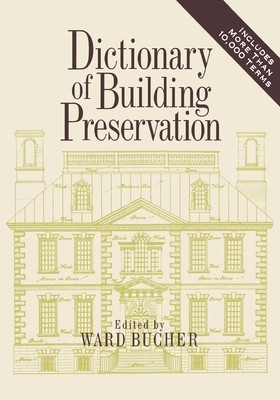
- We will send in 10–14 business days.
- Author: Bucher
- Publisher: John Wiley & Sons
- ISBN-10: 0471144134
- ISBN-13: 9780471144137
- Format: 19.2 x 23.5 x 3.1 cm, minkšti viršeliai
- Language: English
- SAVE -10% with code: EXTRA
Reviews
Description
Most historic buildings are owned by private citizens who havelittle or no background in building preservation or its alliedfields. These owners--as dedicated as they are to preserving orrefurbishing their property--often feel at a disadvantage whencommunicating with professionals well-versed in the complex jargonof this multidisciplinary field. The Dictionary of BuildingPreservation provides easy access to this terminology and helps thenonspecialist to understand and communicate with building anddesign professionals, preservation groups, government agencies, attorneys, and others concerned with building preservation.
Containing more than 10,000 entries that cover the entire breadthof building preservation in North America, this is the best sourceavailable for definitions of terms used for buildings, parts ofbuildings, the development of historic structures, technicalstandards, relevant legal terminology, and preservation practice.It provides detailed information on various historical styles andfashions, structural, mechanical, and electrical systems, andcurrent restoration techniques. In the Dictionary of BuildingPreservation, readers will find* Straightforward definitions that include preservation context, word origin, and national and regional vernaculars
* Many terms that do not appear in any other dictionary
* Cross referencing that allows readers to move from the general tothe specific or vice versa
* Nearly 400 illustrations--many rare-edition prints and linedrawings from the Historic American Buildings Survey as well asfirst edition Architectural Graphic Standards technical drawings
* Both modern and obsolete spellings along with an indication ofthe period in which the term was most commonly used Compiled by a practicing restoration architect, this is the idealreference resource for owners of historic homes, preservationistsand restoration consultants, architecture buffs, urban planners, land-use attorneys, architects and architectural historians, andanyone involved in building renovation, community preservation, orlandmark designation. building types, building parts, construction methods, raw andmanufactured building materials, products and finishes, structuralsystems, architectural styles, room names, Canadian and U.S.national preservation law and administration, government agenciesand preservation organizations, National Register designations, building codes, real estate development, conservation andrestoration treatments, specialty items, archeological terms, abbreviations and preservationist jargon, building types
EXTRA 10 % discount with code: EXTRA
The promotion ends in 22d.00:28:32
The discount code is valid when purchasing from 10 €. Discounts do not stack.
- Author: Bucher
- Publisher: John Wiley & Sons
- ISBN-10: 0471144134
- ISBN-13: 9780471144137
- Format: 19.2 x 23.5 x 3.1 cm, minkšti viršeliai
- Language: English English
Most historic buildings are owned by private citizens who havelittle or no background in building preservation or its alliedfields. These owners--as dedicated as they are to preserving orrefurbishing their property--often feel at a disadvantage whencommunicating with professionals well-versed in the complex jargonof this multidisciplinary field. The Dictionary of BuildingPreservation provides easy access to this terminology and helps thenonspecialist to understand and communicate with building anddesign professionals, preservation groups, government agencies, attorneys, and others concerned with building preservation.
Containing more than 10,000 entries that cover the entire breadthof building preservation in North America, this is the best sourceavailable for definitions of terms used for buildings, parts ofbuildings, the development of historic structures, technicalstandards, relevant legal terminology, and preservation practice.It provides detailed information on various historical styles andfashions, structural, mechanical, and electrical systems, andcurrent restoration techniques. In the Dictionary of BuildingPreservation, readers will find* Straightforward definitions that include preservation context, word origin, and national and regional vernaculars
* Many terms that do not appear in any other dictionary
* Cross referencing that allows readers to move from the general tothe specific or vice versa
* Nearly 400 illustrations--many rare-edition prints and linedrawings from the Historic American Buildings Survey as well asfirst edition Architectural Graphic Standards technical drawings
* Both modern and obsolete spellings along with an indication ofthe period in which the term was most commonly used Compiled by a practicing restoration architect, this is the idealreference resource for owners of historic homes, preservationistsand restoration consultants, architecture buffs, urban planners, land-use attorneys, architects and architectural historians, andanyone involved in building renovation, community preservation, orlandmark designation. building types, building parts, construction methods, raw andmanufactured building materials, products and finishes, structuralsystems, architectural styles, room names, Canadian and U.S.national preservation law and administration, government agenciesand preservation organizations, National Register designations, building codes, real estate development, conservation andrestoration treatments, specialty items, archeological terms, abbreviations and preservationist jargon, building types


Reviews